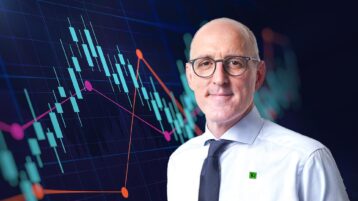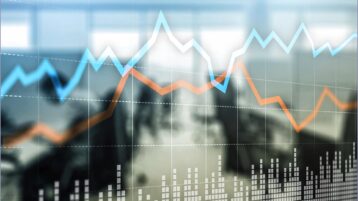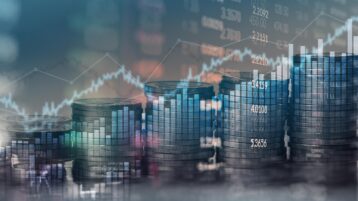The U.S. Federal Reserve is widely expected to raise its key interest rate at its upcoming meeting next week. Hafiz Noordin, Portfolio Manager at TD Asset Management, tells Greg Bonnell the bond market is suggesting that hike may be the last and that a rate cut may come soon after.
Print Transcript
- While we are in the thick of earnings season, the path of interest rates is never far from investors' minds. A number of central banks on deck in the next coming days, including the US Federal Reserve a week from today. Joining us now to discuss what the bond market is telling us, Hafiz Noordin, Portfolio Manager at TD, Asset Management. Hafiz, it's great to have you back on the program.
- Great to be here.
- All right, I feel like this is an earnings season. While there is plenty happening in terms of individual names, and the backdrop is still this large macro concern we have about what central banks are going to do next. What's the bond market saying?
- Yeah. And, you know, we're trying to figure out the end of the rate hike cycle. You know, we're getting close. The story is pretty straightforward in Canada here. We know that the Bank of Canada's been on hold at 4.5% since January. And, from what the market is pricing, that's going to stay that way until the second half of the year.
But outside of Canada, there's still a number of central banks, big ones, that are still trying to get those last few rate hikes in. And so, the next ones that we have on deck, the Bank of Japan, we'll see it overnight on Thursday. And, like you said, the Fed next week, and also the ECB. And why is this important, as a Canadian investor, to monitor this? Well, we know the Bank of Canada can influence short end rates in Canada. But longer-dated bond yields, 10-year yields, 30-year yields, can really be volatile based on what some of these larger, global central banks do.
- Let's talk about the big one, which is a week away. And that'd be the US Federal Reserve. The indication seems to be that they're not done yet. But at the same time, you have some stresses showing up in the banking system south of the border. It's the regional banks, and they have sort of specific things happening for those names.
But it's not something that the Fed can dismiss. I mean, they did acknowledge it last time. But at the same time, it didn't stop them.
- That's right. And number one job still is inflation. There's been encouraging news, at least out of the last CPI print in the US, which was that inflation is elevated. But one of the big drivers of inflation, shelter inflation, did moderate downwards. And we're starting to see what the market was hoping to see and what it was expecting, which was a sort of gradual decline in housing-related inflation. And that usually is kind of the big macro-- defines the big macro trend in US CPI.
Having said that, the breadth of inflation, so the number of categories that are still elevated in the CPI basket, is still high. So for the Fed right now, I think maintaining their credibility around fighting inflation is still critical, which is why we think they will deliver this 25 basis point hike next week, even though we're starting to see these issues around First Republic, as you mentioned. But they do need to deliver that. And then I think the uncertainty is going to be after that, where the markets, interestingly, pricing a reversal of that cut, perhaps in September, maybe even as early as July, because of the--
- So after we stop hiking, the market actually thinks you could be that quick in terms of a turnaround, the pivot, right?
- Yes, yeah.
- I mean, the thing that people kept throwing out the pivot all through last year. You'd see these rallies on pivot hopes that faded.
- Right. Yeah, it's interesting. How do we characterize it? It almost even reads like a policy mistake. What's the point of this last hike?
Well, I think what the market is thinking is that, over the course of the next few months, with this last rate hike, helping to get inflation to come down in a more sustainable way. But also, I think what's been happening is that there's the introduction of more downside risks to growth. We've seen that in the manufacturing sector, but certainly, all of the stress around the banking sector amplifies the risk of downside growth, which is why we'll see cuts, perhaps starting even this summer.
- Now, this gets a little bit more esoteric, for those who are outside of fixed income. But the idea of yield curve control. I get a sense, and correct me if I'm wrong, that maybe when we hear from the Bank of Japan, we might get a little something on that front.
- It's definitely the most topical piece in terms of the Bank of Japan. And going back seven years or so of yield curve control policy that's been there, trying to keep the ten-year yield close to zero. But it's been a very unsustainable policy, especially with global inflation rising, and moreover, because the Bank of Japan, with that policy, and with QE more broadly, now owns over half of the Japanese government bond market.
And so, it's really a poster child of distorting the market. And really, that pressure is there to take that policy back. But it has to be done very gradually, because it's just been such a long-standing policy, that it's very ingrained in terms of how investors, how big investors in Japan, that have been allocating capital.
So what we'll likely see, it may not be at this meeting, but it's really unknown when it'll happen. We'll likely see an increase in the band, the allowed band. Right now, it's half a percent of how much 10-year bond yields in Japan can vary from the 0% target. So if they go from half a percent to 75 basis points, we'll see a lot of volatility in the Japanese bond market. And that could certainly propagate over into our domestic bond market here.
- Would yield curve control become an issue or a tool that a Fed-- US Federal Reserve would want to use, other central banks? Or is this sort of a phenomenon to Japan at the moment?
- I think it was a bit unique to them, just in terms of how far they went with QE. They needed-- they needed something else to be able to guide markets towards keeping borrowing conditions very, very loose. And this goes back, again, seven years ago when inflation was completely non-existent.
I think when you look at the US, Canada, Europe, clearly, we've seen in this cycle that inflation has been alive and well. And I think, going towards the next cycle, the standard tools we've seen in terms of the policy rate and in QE are probably what we're looking at. I think the bar for YCC is very high.
- When we talk about the effects, the cumulative effect of all these aggressive rate hikes and the fact that the market thinks they might have to pivot and turn direction that quickly coming off of hikes and then jumping right into cuts, almost after they're done, what does it tell us about how we're supposed to think about central bank policy? I mean, the whole idea that, OK, we hiked today, and we're not going to see the effect on the economy for 12, 18 months down the road. Are those rules sort of thrown out the window if they've got to be this reactive?
- Well, I think it's that they have to be data-dependent. And the reality is, as much as they like to provide forward guidance, they don't know where things are going. They can provide a base case in their own projections. And the Fed did that at the last meeting.
The market itself is, essentially, an average of a number of different outcomes. And so, yes, there's a base case that they'll hike. And then growth will gradually come down, and inflation will gradually come down.
But there's definitely the hard landing type of scenario, where they may have to even cut quicker than what the market's expecting. On the flip side, there's definitely a scenario where inflation stays stickier than what it's priced in, and that we don't get to a 3% to 4% CPI by the end of the year. And that would mean that rate cuts wouldn't happen this year.
So I think there is still very much a wide range of scenarios. And in terms of central banks, they just have to make sure they are data-dependent, not overly commit to particular policy, and be willing to be flexible.
[AUDIO LOGO]
[MUSIC PLAYING]
- Great to be here.
- All right, I feel like this is an earnings season. While there is plenty happening in terms of individual names, and the backdrop is still this large macro concern we have about what central banks are going to do next. What's the bond market saying?
- Yeah. And, you know, we're trying to figure out the end of the rate hike cycle. You know, we're getting close. The story is pretty straightforward in Canada here. We know that the Bank of Canada's been on hold at 4.5% since January. And, from what the market is pricing, that's going to stay that way until the second half of the year.
But outside of Canada, there's still a number of central banks, big ones, that are still trying to get those last few rate hikes in. And so, the next ones that we have on deck, the Bank of Japan, we'll see it overnight on Thursday. And, like you said, the Fed next week, and also the ECB. And why is this important, as a Canadian investor, to monitor this? Well, we know the Bank of Canada can influence short end rates in Canada. But longer-dated bond yields, 10-year yields, 30-year yields, can really be volatile based on what some of these larger, global central banks do.
- Let's talk about the big one, which is a week away. And that'd be the US Federal Reserve. The indication seems to be that they're not done yet. But at the same time, you have some stresses showing up in the banking system south of the border. It's the regional banks, and they have sort of specific things happening for those names.
But it's not something that the Fed can dismiss. I mean, they did acknowledge it last time. But at the same time, it didn't stop them.
- That's right. And number one job still is inflation. There's been encouraging news, at least out of the last CPI print in the US, which was that inflation is elevated. But one of the big drivers of inflation, shelter inflation, did moderate downwards. And we're starting to see what the market was hoping to see and what it was expecting, which was a sort of gradual decline in housing-related inflation. And that usually is kind of the big macro-- defines the big macro trend in US CPI.
Having said that, the breadth of inflation, so the number of categories that are still elevated in the CPI basket, is still high. So for the Fed right now, I think maintaining their credibility around fighting inflation is still critical, which is why we think they will deliver this 25 basis point hike next week, even though we're starting to see these issues around First Republic, as you mentioned. But they do need to deliver that. And then I think the uncertainty is going to be after that, where the markets, interestingly, pricing a reversal of that cut, perhaps in September, maybe even as early as July, because of the--
- So after we stop hiking, the market actually thinks you could be that quick in terms of a turnaround, the pivot, right?
- Yes, yeah.
- I mean, the thing that people kept throwing out the pivot all through last year. You'd see these rallies on pivot hopes that faded.
- Right. Yeah, it's interesting. How do we characterize it? It almost even reads like a policy mistake. What's the point of this last hike?
Well, I think what the market is thinking is that, over the course of the next few months, with this last rate hike, helping to get inflation to come down in a more sustainable way. But also, I think what's been happening is that there's the introduction of more downside risks to growth. We've seen that in the manufacturing sector, but certainly, all of the stress around the banking sector amplifies the risk of downside growth, which is why we'll see cuts, perhaps starting even this summer.
- Now, this gets a little bit more esoteric, for those who are outside of fixed income. But the idea of yield curve control. I get a sense, and correct me if I'm wrong, that maybe when we hear from the Bank of Japan, we might get a little something on that front.
- It's definitely the most topical piece in terms of the Bank of Japan. And going back seven years or so of yield curve control policy that's been there, trying to keep the ten-year yield close to zero. But it's been a very unsustainable policy, especially with global inflation rising, and moreover, because the Bank of Japan, with that policy, and with QE more broadly, now owns over half of the Japanese government bond market.
And so, it's really a poster child of distorting the market. And really, that pressure is there to take that policy back. But it has to be done very gradually, because it's just been such a long-standing policy, that it's very ingrained in terms of how investors, how big investors in Japan, that have been allocating capital.
So what we'll likely see, it may not be at this meeting, but it's really unknown when it'll happen. We'll likely see an increase in the band, the allowed band. Right now, it's half a percent of how much 10-year bond yields in Japan can vary from the 0% target. So if they go from half a percent to 75 basis points, we'll see a lot of volatility in the Japanese bond market. And that could certainly propagate over into our domestic bond market here.
- Would yield curve control become an issue or a tool that a Fed-- US Federal Reserve would want to use, other central banks? Or is this sort of a phenomenon to Japan at the moment?
- I think it was a bit unique to them, just in terms of how far they went with QE. They needed-- they needed something else to be able to guide markets towards keeping borrowing conditions very, very loose. And this goes back, again, seven years ago when inflation was completely non-existent.
I think when you look at the US, Canada, Europe, clearly, we've seen in this cycle that inflation has been alive and well. And I think, going towards the next cycle, the standard tools we've seen in terms of the policy rate and in QE are probably what we're looking at. I think the bar for YCC is very high.
- When we talk about the effects, the cumulative effect of all these aggressive rate hikes and the fact that the market thinks they might have to pivot and turn direction that quickly coming off of hikes and then jumping right into cuts, almost after they're done, what does it tell us about how we're supposed to think about central bank policy? I mean, the whole idea that, OK, we hiked today, and we're not going to see the effect on the economy for 12, 18 months down the road. Are those rules sort of thrown out the window if they've got to be this reactive?
- Well, I think it's that they have to be data-dependent. And the reality is, as much as they like to provide forward guidance, they don't know where things are going. They can provide a base case in their own projections. And the Fed did that at the last meeting.
The market itself is, essentially, an average of a number of different outcomes. And so, yes, there's a base case that they'll hike. And then growth will gradually come down, and inflation will gradually come down.
But there's definitely the hard landing type of scenario, where they may have to even cut quicker than what the market's expecting. On the flip side, there's definitely a scenario where inflation stays stickier than what it's priced in, and that we don't get to a 3% to 4% CPI by the end of the year. And that would mean that rate cuts wouldn't happen this year.
So I think there is still very much a wide range of scenarios. And in terms of central banks, they just have to make sure they are data-dependent, not overly commit to particular policy, and be willing to be flexible.
[AUDIO LOGO]
[MUSIC PLAYING]



























